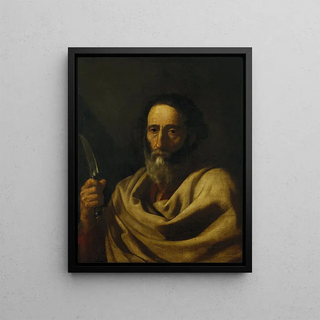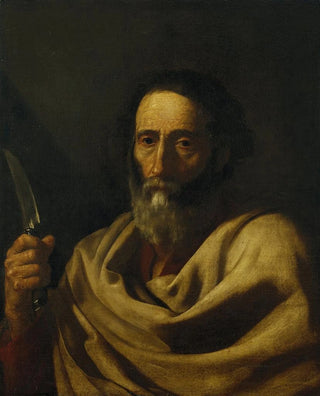Art print | Saint Barthélemy - Jusepe de Ribera


View from behind

Frame (optional)
Saint Barthélemy - Jusepe de Ribera – Captivating Introduction
In the fascinating world of baroque art, the "Saint Barthélemy" art print by Jusepe de Ribera stands out for its expressive power and dramatic intensity. This depiction of the saint, martyred for his faith, immerses us in a moment of deep reflection and contemplation. Through this piece, Ribera transcends mere religious representation to offer a meditation on suffering and spirituality. The art print, through its composition and palette, engages the viewer and invites reflection on the nature of faith and sacrifice. The art print Saint Barthélemy - Jusepe de Ribera thus allows for rediscovering this masterpiece while paying tribute to the virtuosity of its creator.
Style and uniqueness of the work
Ribera's style is characterized by striking realism, where light and shadow play a fundamental role in staging the characters. In "Saint Barthélemy," the saint is depicted with an expressiveness that captures attention. His face, marked by profound pain, reflects the inner struggle between faith and suffering. The meticulous details of the flesh and drapery give the work an almost tactile dimension, allowing the viewer to feel the gravity of the moment. The color palette, dominated by dark and earthy tones, enhances the dramatic atmosphere of the scene. Every brushstroke seems loaded with meaning, revealing a technical mastery that makes Ribera an undisputed master of Spanish baroque.
The artist and his influence
Jusepe de Ribera, born in 1591 in Játiva, Spain, is often regarded as one of the greatest painters of his time. Trained in Italy, he successfully integrated Caravaggio's influences while developing a personal style unique to him. His work is characterized by a realistic portrayal of human figures, often marked by suffering but also by palpable spirituality. Ribera captured the very essence of the human condition, rendering his characters both accessible and deeply moving. His influence extends beyond his era, inspiring many artists who sought to explore the themes

Matte finish

View from behind

Frame (optional)
Saint Barthélemy - Jusepe de Ribera – Captivating Introduction
In the fascinating world of baroque art, the "Saint Barthélemy" art print by Jusepe de Ribera stands out for its expressive power and dramatic intensity. This depiction of the saint, martyred for his faith, immerses us in a moment of deep reflection and contemplation. Through this piece, Ribera transcends mere religious representation to offer a meditation on suffering and spirituality. The art print, through its composition and palette, engages the viewer and invites reflection on the nature of faith and sacrifice. The art print Saint Barthélemy - Jusepe de Ribera thus allows for rediscovering this masterpiece while paying tribute to the virtuosity of its creator.
Style and uniqueness of the work
Ribera's style is characterized by striking realism, where light and shadow play a fundamental role in staging the characters. In "Saint Barthélemy," the saint is depicted with an expressiveness that captures attention. His face, marked by profound pain, reflects the inner struggle between faith and suffering. The meticulous details of the flesh and drapery give the work an almost tactile dimension, allowing the viewer to feel the gravity of the moment. The color palette, dominated by dark and earthy tones, enhances the dramatic atmosphere of the scene. Every brushstroke seems loaded with meaning, revealing a technical mastery that makes Ribera an undisputed master of Spanish baroque.
The artist and his influence
Jusepe de Ribera, born in 1591 in Játiva, Spain, is often regarded as one of the greatest painters of his time. Trained in Italy, he successfully integrated Caravaggio's influences while developing a personal style unique to him. His work is characterized by a realistic portrayal of human figures, often marked by suffering but also by palpable spirituality. Ribera captured the very essence of the human condition, rendering his characters both accessible and deeply moving. His influence extends beyond his era, inspiring many artists who sought to explore the themes






